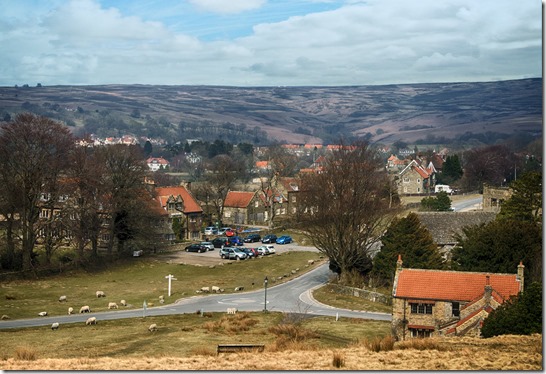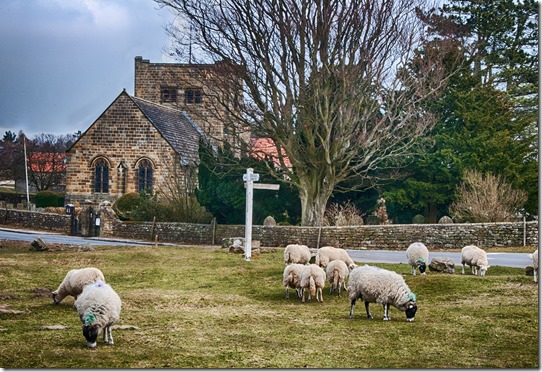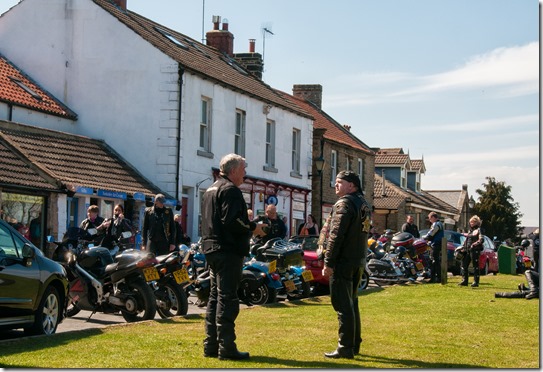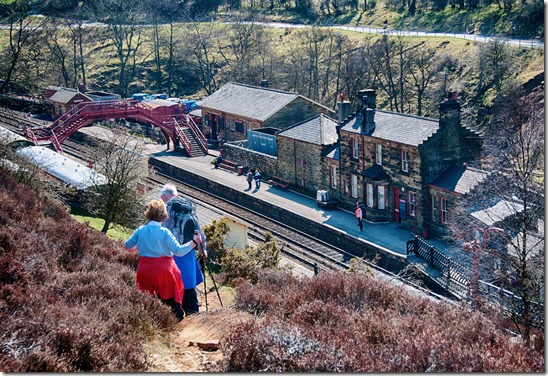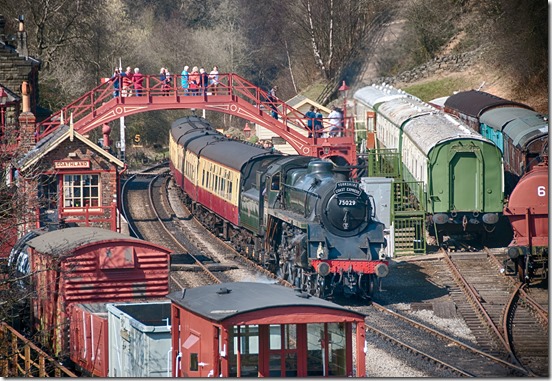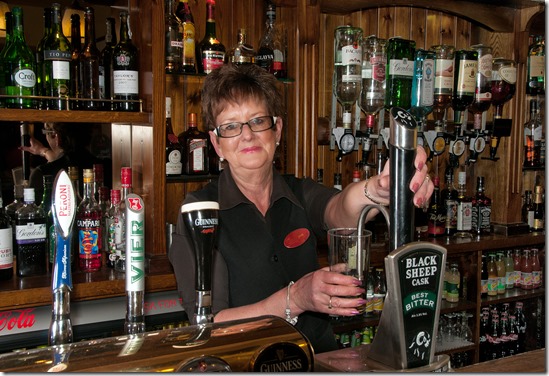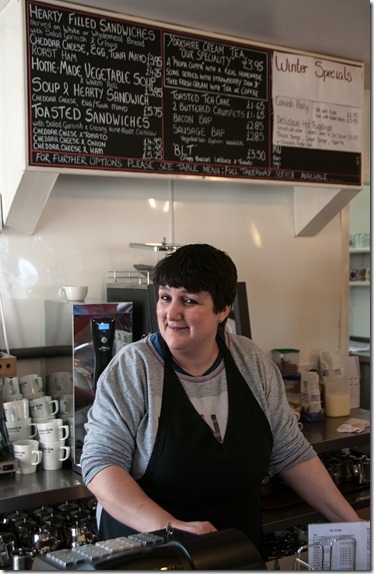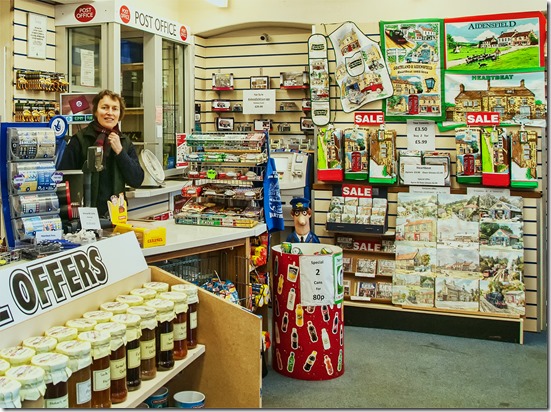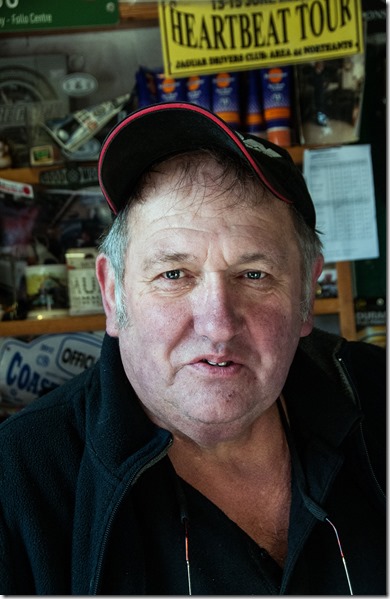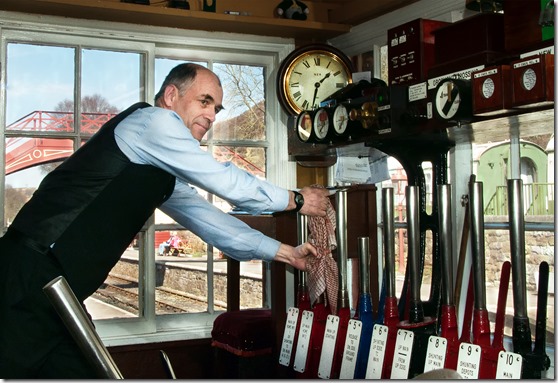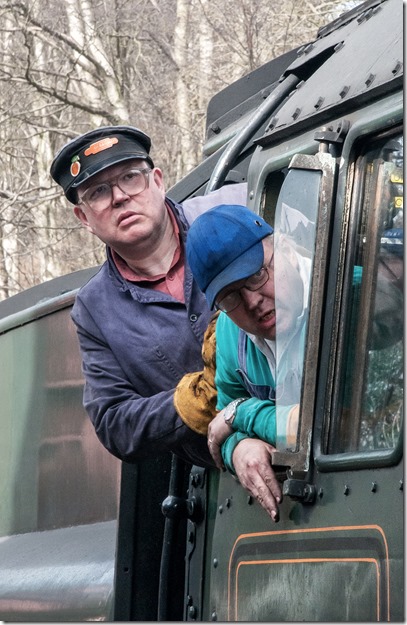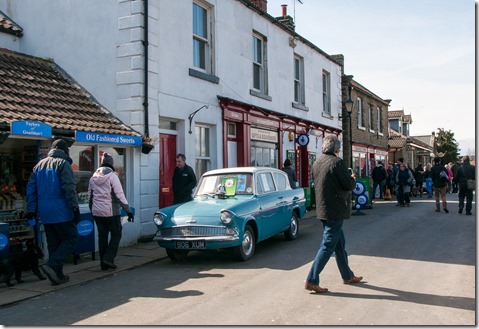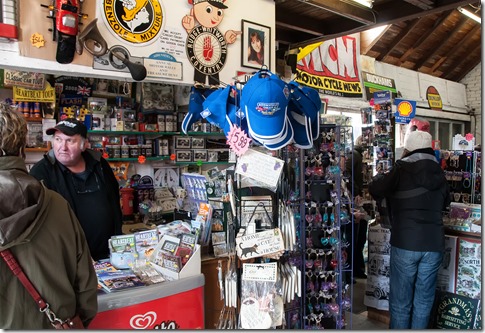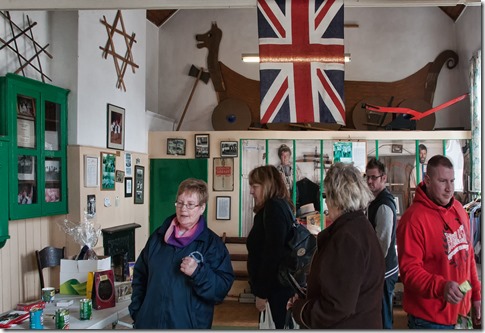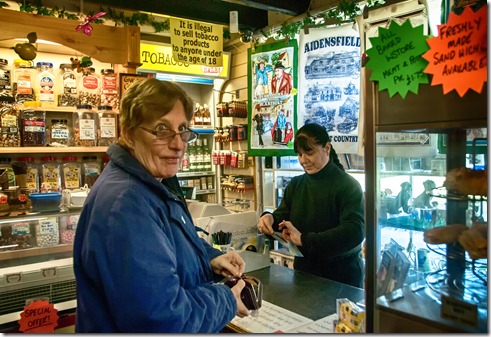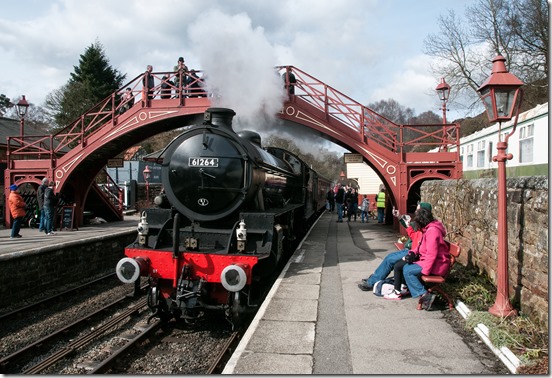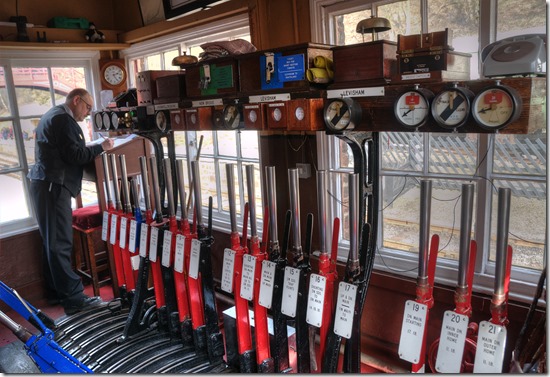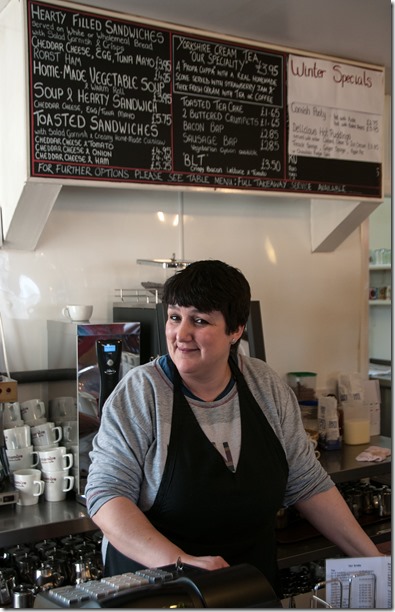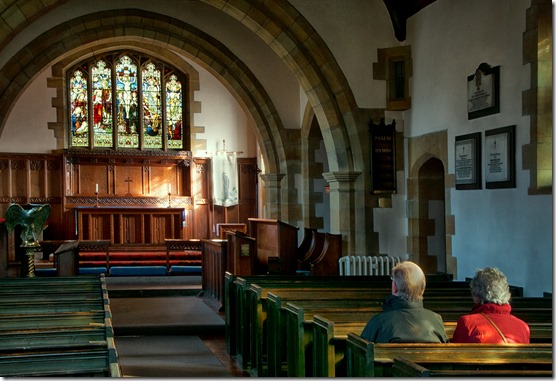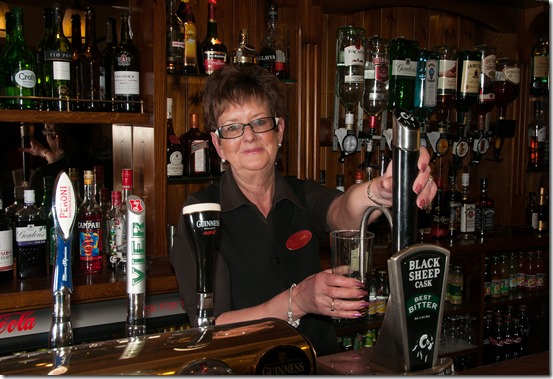Once again my tutorial showed that improvements could be made to this assignment. The selected photographs could be improved and a ‘unified’ style developed – as they stand, there are several different types of presentation which make the overall assignment disjointed. Also, some of the images could have been taken anywhere – they didn’t necessarily relate to the village. With these points in mind I undertook to start again. Firstly I’ll look at the village itself – this venue is all about the great outdoors, so this needs to be shown, apart from the people who live and work there, who will be shown in the second part.
Images which show the village and its peculiarities /individuality are not necessarily taken within the premises / businesses. People come to the village to enjoy the moorland walks, see the real life ‘Aidensfield’ and relive the days of steam travel at the station, so this is what I’ll try to portray here.
Entering the village from the West its position in the moorland can be appreciated:
West End
This end of the village is away from the ‘Heartbeat’ experience. Here the sheep wander around with little interruption from tourists. To the left we can travel to see the remains of the Roman Road which ran from Whitby to York. To the right the road heads towards RAF Fylingdales, Early Warning Station. The Mallyan Spout Hotel, where the cars are parked, is at the top of a path which leads to the foot of an impressive waterfall (The Mallyan Spout).
Across the road from the hotel is the church:
St Mary’s Church
This beautiful little 19th century church is an important part of the village life which seems to be well respected by the villagers. There has been a place of worship on this site for over 800 years – predating this church which was built in 1896. As well as its religious uses it’s a place for quiet reflection – the doors are always open for visitors.
Here the sheep are prevalent and there’s a calmness and openness of the moors. It’s away from the tour buses and souvenir hunters. This is where to come to be at peace with the world. For me, this is what the area is all about – come here to enjoy the walks and beauty of the moors.
Walking almost half a mile to the other end of the village we come to the more commercial area:
The Green
The Green is the name of the high street. This is where the tourists come for their ‘Heartbeat’. There are also essentials like the Post Office, outdoor clothing supplies and an excellent tearoom. As can be seen here, it’s a place that motorcycle clubs use as a meeting place.
Moving further down the road we pass the reading room and on to the garage:
Aidensfield Garage
Changed from a working garage into a souvenir shop for ‘Heartbeat’ – There’s an Austin A30 on a lift and a couple of old motor cycles inside, but mainly it’s ‘Heartbeat memorabilia. This venue is a must for those looking for ‘Aidensfield’, but I’m afraid it doesn’t do it for me – I think it’s lost its soul. Still, they seem to be making a living from it.
After the garage and the ‘Aidensfield Arms’ on the other side of the road, we come back into the real Goathland. Here the hikers who come to appreciate the walks can be seen:
East End
Climbing down the moorland path from Beck Hole (another wonderful village – with the smallest inn in Yorkshire) we come upon Goathland station. It’s another of those prizes that keep springing up during the walks across the moors. Again it’s what I think the real village is about.
The Station
The steam trains always attract a crowd. It’s easy to get close to the trains, so visitors get the opportunity to appreciate the atmospherics and rawness of the engines with the quaintness and glory of the rolling stock. It was renamed ‘Hogsmeade’ for Harry Potter, but it’s not made a great thing of. With trains running almost every hour and using the station as a passing point on the otherwise single track railway, there’s plenty to see and the volunteers who operate it are always pleased to tell you about it and show you what they can. This is a ‘must see’ venue for the North Yorkshire Moors, never mind Goathland. With so much going on here, the station could become an assignment itself!
Next we look at six people who live and work in the village. Working through the village in the same sequence, we start at the Mallyan Spout Hotel:
The Public Bar
With pleasant, welcoming staff; warm comfortable lounges; excellent restaurant and real ale in the bars. What more could you ask for.
It’s away from the bustle of The Green, so it’s a place to go to relax. It’s a good base to explore many parts of the North Yorkshire Moors – as well as the scenery there are ancient crosses, standing stones and Roman relics to explore. For me, this is what the
village is all about and the owners and staff of the Mallyan Spout have got it just right.
Moving on to The Green, we first visit the Tearooms:
Tea Rooms
The cheerfulness and openness of the staff here is wonderful, particularly on a cold day. Good, simple food, served by cheerful people in comfortable surroundings is what this café is all about. In the winter there’s a fire burning and when it gets warmer there’s a garden area. All very pleasant and well recommended.
Still on ‘The Green’ we check out the Post Office:
The Post Office
This shop is so obviously much more than the post office. Like other businesses in the village it’s very much aimed at the tourist industry. Here there are souvenirs to be bought alongside the stamps, lottery tickets and cigarettes. I was pleasantly surprised at the reception of the postmaster and postmistress when they were happy to allow me to photograph here – I thought there would be some objection as it’s a post office, but they were as accommodating as everyone else in the village. It’s obvious that tourism is welcomed here with open arms.
Aidensfield Garage
Now a souvenir shop cum motoring memorabilia store. The owner has been there for 40 years and ran it as a working garage before the television series changed everything. He says he’s happy with his new business, but that wasn’t what came across to me. Together with the landlord of the Goathland Hotel (aka Aidensfield Arms) they are the only two of all the people I got to know during this village assignment that didn’t seem happy with their lot – they’re still here after all the years, so they must be happy with their businesses at one level.
Moving on to the station we again find cheerful, friendly faces:
The Signal Box
Operated by volunteers, the signal box controls train movement on the North Yorkshire Moors Railway. It’s an intriguing place with different sounding bells from different signal boxes to alert the signalman of a train passing in his direction, interlocks which will not allow signals to be changed if the points are in the wrong position and so many telephones. There’s nothing automated about this system but it works really well – the Victorians certainly knew about engineering. Every movement and communication must be logged – that’s what the signalman is doing here. Although this area is not generally open to the public, you only have to ask and the signalman is more than happy to give you a guided tour if he’s not busy with a switching operation. For photographers, this is also the place to obtain your trackside access permit and fluorescent jacket.
Engine Driver and Fireman
Following an emergency stop due to a visitor getting too close to the moving train, these two are awaiting the ‘all clear’ from the station master before setting off again. It’s good to know that we’re in safe hands!
Assessment of the project:
I believe I achieved what I set out to do regarding seeing how the locals have adapted to their change of lifestyles. Some have made the transition better than others. There are examples where the owners don’t seem happy with their lot, possibly due to the downturn in their trade as recession bites and the ‘Heartbeat’ series has finished. Similarly there are those who will survive because of their friendliness and openness – their service will keep customers coming back. I think it’s a bit worrisome that there’s so much emphasis on ‘Heartbeat’ – this interest must wane soon and the businesses that rely on this now could be left high and dry. The railway and the walking will always be there – neither of these activities mentions any of the ‘Harry Potter’ or ‘Heartbeat’ series, so they’ve still got sound bases to work from.
I was thwarted to some degree by the poor weather, which delayed the photography for almost a month and necessitated wearing heavy clothing while reducing the amount of photographic equipment. Also, one of the venues’ proprietors was a little reluctant to allow my access, but I feel I still managed to fulfill my remit.
I had a problem deciding which images to use. A great deal about the village is what can be seen outdoors, hence the views of the high street and the walkers, so I would have preferred a bigger allowance on the number of final photographs. I feel that what I’ve produced is just a snapshot of the village when there are places which I couldn’t consider including.
Following the initial tutorial, I’ve learned that I should have a more unified approach for the final presentation. It was also good to be given permission to present two differing types of photography – one which shows the ‘outdoors’ aspect of the village and one which shows the ‘people’ of the village, so in effect there are two presentations here, which allowed me to give a reasonable representation of what makes the place so attractive.
Having a defined end-result certainly concentrated the mind when taking the photographs, although I did deviate to capture images of the heather burning which I’ll keep as stock images for further investigation and images from the railway station will be similarly held. If I hadn’t had a defined remit I wouldn’t have concentrated so much on the job in hand, so the outcome could have been much more fragmented and not cohesive.
I’ve certainly learned a lot about the people of Goathland and made some new friends on the way. I’ve also found some excellent coffee and well-kept beer!
